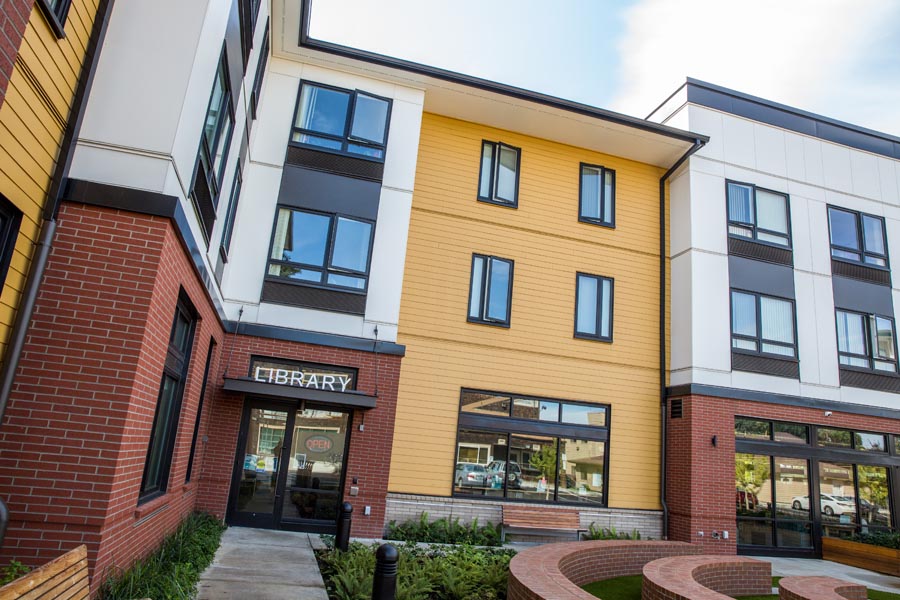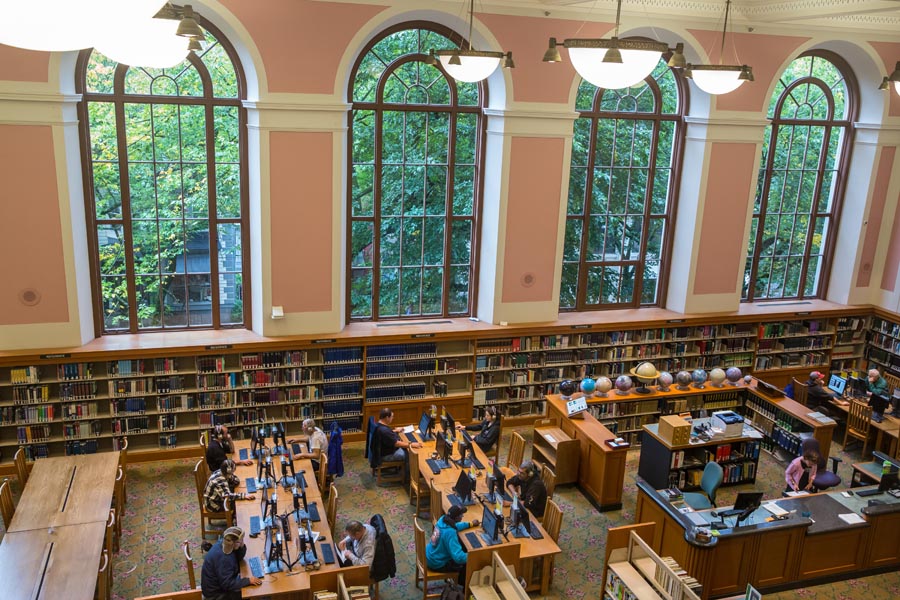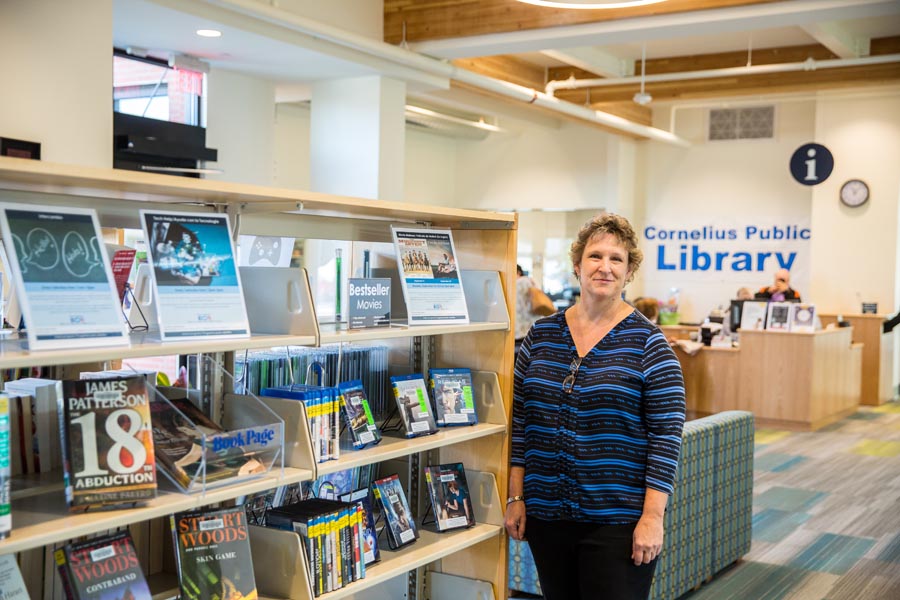Business development catalyst, community hub or social services center, Oregon’s public libraries have evolved to serve all.
After 10 years of fundraising, dealmaking and creative partnership building, the small city of Cornelius on Washington County’s western edge finally opened a new library.
Located in downtown, the three-story, 15,000-square-foot structure is a far cry from the old, cramped facility.
The building hosts study rooms, meeting space, a business center and more.
It checks out laptops for patrons to take home and screens movie matinees geared toward seniors. There’s a large children’s area and a cool hangout room for teens.
An art gallery and coffee shop are in the works, and the outdoor courtyard has already hosted three evening concerts with more programming, such as a weekly farmers market, to come.
Oh, and there are books too.
It’s a big notch in the belt of one of Washington County’s smallest and poorest cities. But the Cornelius Public Library represents in miniature the evolution going on in libraries around Oregon and the rest of the country.
 The new Cornelius Public Library in Washington County Credit: Jason Kaplan
The new Cornelius Public Library in Washington County Credit: Jason Kaplan
Libraries have always been important gathering spots, places where everyone and anyone is welcome, free of charge. That community living room role, also known as the “third space,” has become even more vital as town halls, rural grange halls and other traditional civic gathering spots give way to for-profit hangouts such as coffee shops and shopping areas.
Today, however, more and more libraries have also become de facto “second responders.” Already the most trusted government institution, according to a study by the Urban Libraries Council (so trusted, in fact, that often people don’t realize the public library is a government service), library employees are used to helping patrons research questions around topics such as health and the law.
But now workers find themselves on the front line of systemic social issues. They’re tackling the day-to-day realities of homelessness, mental illness, food insecurity and other problems not addressed in classic librarian training.
“I never thought that when I went to library school, I would be talking so much about public bathrooms,” says Multnomah County Library director Vailey Oehlke with a laugh.
Yet visitors, turned off by homeless patrons hanging out in the Central Library, Portland’s iconic downtown branch, insist on having that conversation.
In answer, libraries around the state are reexamining the way they hire and train staff, set policy and design programs. But as they work to create safe, respectful spaces, some things will never change.
 The Central Library, Portland. Credit: Jason Kaplan
The Central Library, Portland. Credit: Jason Kaplan
The public library will always be public. It will always be a community hub. And it will always present an opportunity to plant the flag of civic pride.
Under the right circumstances, however, the public library can also be an economic development tool.
That’s the strategy in Maupin. The tiny Central Oregon city (population 430) plans to open its 6,000-square-foot civic center in January 2020. The project will house City Hall, meeting space and a new 2,800-square-foot public library.
Tied to the creation of the city’s innovative, high-speed broadband fiber network and planned expansion of its medical clinic, the library is one of “three legs of the same stool of bringing our small community into the 21st century,” according to Maupin Mayor Lynn Ewing.
Ewing acknowledges that the library’s first goal is to provide needed services and programs to the 3,400 people who live in South Wasco County. Open six days a week, the library already has engaged patrons.
“We see about 12 people a day now,” estimates librarian Bronte Dod. She projects that number to double once the new building opens. “There are very few free, indoor public spaces in Maupin. This is creating a community space where people can just come and be.”
But Maupin’s mayor is betting the library will be more than a cool hangout for residents and tourists. “It also makes a statement that, unlike some other small former mill towns, we are open for business and moving forward,” he says.
Ewing reports an early halo effect as nearby business owners spruce up their properties. He ultimately thinks the $2.6 million investment — which came from a mix of state and local funds, charitable organizations and local donations — will “attract new residents and hopefully some new businesses.”
RELATED STORY: Fertile Future
In contrast, Cornelius’ library director, Karen Hill, sees her city’s new facility as less of an economic catalyst and more of a focal point, filling local needs. “Cornelius lacks a lot of resources. We don’t have a cultural arts center or a senior center or a youth center,” she says. “This library is all of those things.”
It’s also housing.
Forty-five units of affordable senior housing occupy the building’s second and third floors. This partnership — first with affordable housing nonprofit Bienestar to build the units, then with nonprofit developer BRIDGE Housing to manage them — was the only way to make the $20 million structure pencil out.
 Cornelius Public Library director Karen Hill. Credit: Jason Kaplan
Cornelius Public Library director Karen Hill. Credit: Jason Kaplan
Senior housing, which allows for smaller apartments and less parking, made the most sense on the constricted site. Eleven of the units are reserved for residents using Section 8 vouchers, which help families pay for housing.
The city’s portion of the bill came to $5.8 million, and long-term expenses are shared.
“I look at the roof and see only one-third of the maintenance costs,” says city manager Rob Drake.
Before becoming city manager, Drake was the longtime mayor of Beaverton, overseeing the completion of its central library project. He’s witnessed the positive effect that library brought to downtown.
While he doesn’t predict a building boom of the same magnitude coming to Cornelius, Drake acknowledges the investment brings positive recognition and foot traffic to the area.
“We used to have very little activity around here after 6 p.m.,” he says. “Now you see people walking around and coming to the library until 8:00.”
Library usership is high throughout the Pacific Northwest, and the city of Hillsboro is no exception. Its two-branch library system serves 100,000 people but circulates 3 million items a year. These numbers put the library on par with cities three to four times larger.
While their libraries were always well used and well loved, library leaders wanted to make sure the entire community, which is 40% non-white, felt welcome.
“Our mission statement is simple: For Everyone/Para Todos,” says Hillsboro director of libraries Stephanie Chase.
Removing barriers to participation started with removing an actual, physical barrier: the front desk. With that gone, patrons can now pick any available staff member for help.
They usually gravitate toward someone who looks like them, speaks their language or shares their culture. But this can be a challenge as librarians are, for the most part, white and female.
To boost staff diversity, Hillsboro changed the way it hires assistants by prioritizing customer service skills over library experience.
“I can teach the right people all the things we do in the library, but I can’t teach customer service,” says Hillary Ostlund, Hillsboro library manager. “And customer service is the main service we provide.”
Ostlund posted job openings in untraditional places such as Craigslist and Centro de Prosperidad Economic Empowerment Center, a workforce development program.
She also changed the requirements. Applicants didn’t need library experience, an advanced degree or even a bachelor’s degree. Two years of customer service experience, a willingness to learn on the job and a love of libraries were required.
She received 736 applications for 12 positions, a record for any city job.
A diverse staff may remove barriers, but it doesn’t solve one of the biggest issues facing West Coast libraries today: homelessness. As of January 2018, Oregon has 14,476 people experiencing homelessness, according to the U.S. Department of Housing and Urban Development.
Many camp on library grounds at night. More hang out inside the building all day. Some misuse the facilities.
Which is why some people will not go into the bathroom at Portland’s Central Library.
“Yes, we have people experiencing homelessness here because they have nowhere else to go,” says Oehlke. “The library is one of the very few spaces in the community where people can experience a degree of dignity and respect.”
And yes, use the bathroom.
While no one expects libraries to solve the homeless crisis, they do have to manage it. Most have a code of conduct, such as no sleeping, no big bags and no bathing in the bathroom, which applies to everyone.
Multnomah County Library has a “Person In Charge” or PIC, who checks on restrooms and other spaces and knows how to de-escalate an issue.
It was also one of the first library systems to have social workers on staff, a trend that is catching on around the state and country. “At our most fundamental, we are about connecting people with resources,” says Oehlke.
The Eugene library is developing programming, such as healing yoga and art, specifically tailored for homeless patrons who congregate in the atrium garden before the library officially opens.
“We’re trying to address the whole person,” says Eugene Public Library services director Will O’Hearn. “Sheltered or unsheltered, we are all looking for the same things, to be part of the community.”
And in Oregon, the community loves the library back. Or at least the majority does, as witnessed by the reopening of all of the libraries in Douglas County. Once fully funded by timber money, the county libraries closed after a failed 2016 tax proposal.
Today they are all back and operating in some shape or form. “That speaks to the livability and vitality of this community,” says Roseburg Public Library director Kris Wiley.
RELATED STORY: Rural Libraries Turn More to Private Sector For Funding
The Roseburg Library has taken over one-third of the former Douglas County Library headquarters (the county education services district took another one-third, and the two entities share the rest of the space).
With an operating budget of nearly $430,000 funded by the city, Wiley reports serving 4,267 cardholders, 600 of which pay a membership fee.
Social worker, civic booster and educator, libraries have always been more than a building with books. Some of that mission will never change, some will. “Libraries still do a lot of heavy lifting for education, but now there’s a much broader recognition of different people’s needs and interests,” says Chase.
You can see it in its offerings. Business classes, multilingual story hours and maker spaces outfitted with 3D printers, laser cutters and fancy sewing machines are now business as usual.
And if the experiments in Cornelius and Maupin pan out, add economic hub to the list.
To subscribe to Oregon Business, click here.






